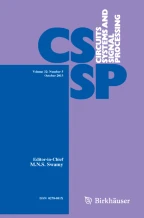Abstract
A novel technique is proposed for selecting iterative updates and step sizes based on adaptive function values to compensate for the slow convergence rate of artificial bee colony optimization (ABCO). On this basis, a blind source separation (BSS) algorithm is proposed based on adaptive ABCO and kurtosis, which does not impose any hypothetical requirements on the source signal. By using kurtosis as the objective function, the algorithm can separate signals that follow any distribution. BSS results from various test distributions demonstrate the superior performance of the proposed algorithm compared to conventional methods.
Similar content being viewed by others
References
M.H. Ahmed, M. Ali, A.W. Khan, Denoising low-dose CT images using multiframe blind source separation and block matching filter. IEEE Trans. Radiat. Plasma Med. Sci. 2(4), 279–287 (2018)
L. Chen, L.Y. Zhang, Y.J. Guo, Blind signal separation algorithm based on temporal predictability and differential search algorithm. J. Commun. 36(6), 117–125 (2013)
A. Cichocki, S. Amari, K. Siwek, ICALAB toolboxes. http://www.bsp.brain.riken.jp/ICALAB/ICALABSignalProc/benchmarks (2017). Accessed 18 Jan 2018
D. Karaboga, B. Akay, A modified artificial bee colony algorithm for constrained optimization problems. Appl. Soft Comput. 11(3), 3021–3031 (2011)
D. Karaboga, An Idea Based on Honey Bee Swarm for Numerical Optimization (Erciyes University, Kayseri, 2005)
J. Kennedy, R.C. Eberhart, Particle swarm optimization. Proc. IEEE Int. Conf. Neural Netw. 1995, 1942–1948 (1995)
C. Kervozo, J. Bobin, C. Chenot, Blind separation of a large number of sparse sources. Sig. Process. 150(9), 157–165 (2018)
M.H. Md, E.L. Benjamin, D. Thapa, Blind source separation-based motion detector for imaging super-paramagnetic iron oxide(SPIO) particles in magnetomotive ultrasoun imaging. IEEE Trans. Med. Imaging 37(10), 2356–2366 (2018)
N. Mourad, P. James, T. Kiruarajant, Majorization–minimization for blind source separation of sparse sources. Sig. Process. 131(2), 120–133 (2017)
G.R. Naik, Measure of quality of source separation for sub- and sup-Gaussian audio mixtures. Informatica 23(4), 581–599 (2012)
J.A. Palmer, M. Scott, Contrast functions for independent subspace analysis. Int. Conf. Latent Var. 2012, 115–122 (2012)
S. Rahnmayan, H.R. Tizhoosh, M.A. Magdy, Opposition-based differential evolution. IEEE Trans. Evol. Comput. 12(1), 64–79 (2008)
Z.W. Shi, H.J. Zhang, Z.G. Jiang, Hybrid linear and nonlinear complexity pursuit for blind source separation. J. Comput. Appl. Math. 236(14), 3434–3444 (2013)
G. Sivan, Y. Yair, G. Idan, Power systems topology and state estimation by graph blind source separation. IEEE Trans. Signal Process. 67(8), 2036–2051 (2019)
L. Wang, A. Cavallaro, Pseudo-determined blind source separation for Ad hoc microphone networks. IEEE Trans. Audio Speech Lang. Process. 26(5), 981–994 (2018)
R.J. Wang, Research on Blind Source Separation: Sequential, Adaptive and Underdetermined (Chemical Industry Press, Beijing, 2016)
R.J. Wang, Application of Artificial Bee Colony Algorithm (Publishing House of Electronics Industry, Beijing, 2016)
R.J. Wang, Y.J. Zhan, H.F. Zhou, A class of sequential blind source separation method in order using optimization algorithm. Circuits Syst. Signal Process. 35(9), 3220–3243 (2016)
A.Q. Zhang, L.L. Zhang, M.S. Li, Identification of dominant low frequency oscillation modes based on blind source separation. IEEE Trans. Power Syst. 32(6), 4774–4782 (2017)
X.D. Zhang, Modern Signal Processing (Tsinghua University Press, Beijing, 2015)
Acknowledgements
This work was supported in part by the National Natural Science Foundation of China under Grant No. 51879118, in part by the High-Level Talent Training Project in the Transportation Industry under Grant No. 2019-014, in part by the National Natural Science Foundation of Fujian Province under Grant No. 2020J01688, in part by the Fujian Province Office of Science and Technology Support for Army under Grant No. B19101, in part by the Foundation of Fujian Education Committee of China for New Century Distinguished Scholars under Grant No. B17159, in part by the Scientific Research Foundation of the Key Laboratory of Fishery Equipment and Engineering at Ministry of Agriculture of the People’s Republic of China under Grant Nos. 2016002 and 2018001, in part by the Scientific Research Foundation of the Artificial Intelligence Key Laboratory of Sichuan Province under Grant No. 2017RYJ02, and in part by the Scientific Research Foundation of the Jiangsu Key Laboratory of Power Transmission & Distribution Equipment Technology under Grant No. 2017JSSPD01.
Author information
Authors and Affiliations
Corresponding author
Additional information
Publisher's Note
Springer Nature remains neutral with regard to jurisdictional claims in published maps and institutional affiliations.
Rights and permissions
About this article
Cite this article
Wang, R. Blind Source Separation Based on Adaptive Artificial Bee Colony Optimization and Kurtosis. Circuits Syst Signal Process 40, 3338–3354 (2021). https://doi.org/10.1007/s00034-020-01621-5
Received:
Revised:
Accepted:
Published:
Issue Date:
DOI: https://doi.org/10.1007/s00034-020-01621-5
